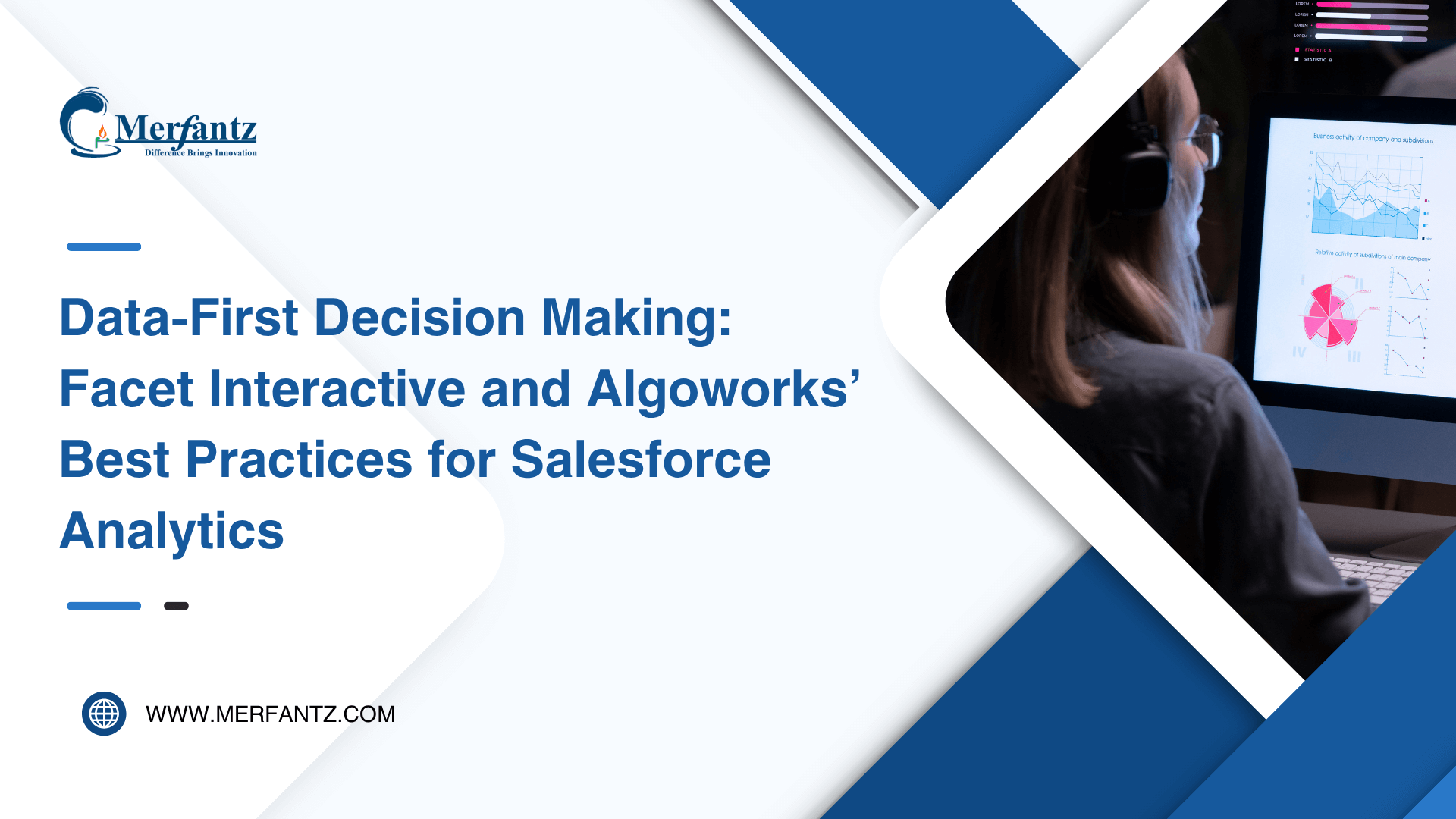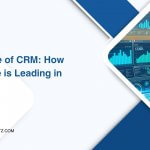
Did you know companies using data-first strategies see 8x higher customer retention than those relying on intuition alone? In an era where 90% of the world’s data was created in the last two years, businesses that harness this flood of information are redefining success.

Modern organizations are shifting from guesswork to granular insights. Tools like CRM systems now act as central hubs for analyzing customer data, uncovering patterns that drive smarter strategies. This approach transforms raw numbers into clear roadmaps for growth.
Facet Interactive and Algoworks specialize in helping teams unlock their CRM’s full potential. Their methods turn complex datasets into easy-to-use dashboards, highlighting key performance indicators that matter most. Imagine spotting sales trends weeks before competitors or predicting customer needs with precision.
This guide explores practical ways to implement these strategies. You’ll learn how to identify high-value opportunities, streamline operations, and create personalized experiences at scale. Let’s dive into the systems reshaping how businesses operate in the data age.
Key Takeaways
- Data-first strategies significantly improve customer retention and operational efficiency
- Modern CRM systems centralize data analysis for actionable business insights
- Specialized partners enhance CRM capabilities through tailored implementation
- Dashboard visualization simplifies complex data interpretation
- Proactive trend analysis creates competitive advantages
Introduction to Data-First Decision Making
The average company now makes more daily choices than entire industries did decades ago. This explosion of decisions demands a new approach – one where every choice starts with hard evidence rather than hunches.
Why Facts Beat Guesswork
Data plays crucial role in modern business strategies. Organizations using structured information approaches report:
- 47% faster identification of market opportunities
- 35% reduction in operational waste
- 22% higher customer satisfaction scores
Turning Theory Into Action
This guide focuses on practical methods to make data-driven decisions that stick. We’ll show you how to:
- Connect disparate data sources into clear narratives
- Spot hidden patterns before competitors
- Build team-wide confidence in factual strategies
By helping businesses gain insights from their existing information, we create decision frameworks that adapt as markets change. The result? Teams that make informed decisions faster, with measurable outcomes that justify every move.
Understanding Salesforce Analytics
What separates thriving businesses from those stuck in analysis paralysis? Modern CRM platforms turn information overload into strategic fuel. These systems combine scattered data points into clear pathways for growth.

Key Components and Benefits
Powerful data tools combine three essential elements:
- Custom dashboards that adapt to team needs
- Predictive models forecasting customer behavior
- Real-time visualizations spotting trends instantly
Teams using these features report 31% faster decision cycles. Operational bottlenecks become visible through automated reports. Marketing groups personalize campaigns using purchase pattern insights.
The Role of Analytics in CRM Systems
Centralized data hubs create complete customer profiles. Service teams resolve issues faster by seeing past interactions. Sales leaders identify high-potential leads through deal velocity tracking.
This approach transforms raw numbers into relationship-building opportunities. Companies using integrated CRM insights achieve 19% higher cross-sell rates. The result? Data becomes the common language driving every department forward.
Salesforce analytics best practices
Structured approaches to information management separate industry leaders from laggards. It starts with ironclad data governance – policies that maintain consistency across every customer touchpoint. Regular quality checks and automated validation keep your foundation rock-solid.
Effective utilization of CRM systems requires laser focus. Teams should define 3-5 core metrics directly tied to revenue growth or customer satisfaction. This alignment ensures everyone works from the same playbook.
Smart organizations leverage CRM tools by building tailored dashboards for different roles. Marketing sees campaign performance, while service teams track resolution times – all with appropriate access controls. This targeted approach turns raw numbers into team-specific action plans.
Knowledge gaps sink even the strongest strategies. Regular training sessions help staff interpret trends correctly, transforming insights into process improvements. Pair this with quarterly system reviews to optimize sales processes through continuous monitoring and iterative adjustments.
Analytics empower organizations to spot trends before they become obvious. By aligning these insights with business goals, companies create self-improving systems that drive measurable outcomes year after year.
Leveraging Real-Time Data Visualization
Modern businesses operate at the speed of light, where delayed insights mean missed opportunities. Real-time data visualization acts as a digital spotlight, illuminating critical patterns in customer behavior and operational performance as they unfold. This approach turns time-sensitive information into actionable intelligence.

Interactive Charts and Graphs
Dynamic visual tools transform number-heavy reports into engaging stories. Users can explore key components through clickable elements, adjusting timeframes or filtering results by region. A sales manager might spot underperforming territories by hovering over a heat map, while marketers track campaign surges through live-updating bar charts.
These interactive features enable teams to gain valuable insights without technical expertise. Drag-and-drop interfaces let users create custom comparisons, while drill-down capabilities reveal hidden correlations between metrics. It’s like having a conversation with your data – ask questions, get instant answers.
Identifying Trends Instantly
Pattern recognition becomes effortless when information flows visually. Sudden drops in customer engagement flash red on dashboards, while emerging product preferences glow green. Teams can:
- Compare current performance against historical benchmarks
- Track metric movements across multiple dimensions
- Receive automated alerts for predefined thresholds
This visual early-warning system helps organizations pivot before issues escalate. When a retail chain notices real-time inventory shortages through color-coded maps, they can reroute shipments immediately. Real-time data visualization doesn’t just show what’s happening – it reveals what to do next.
Customizing Dashboards and Reports
Tailored data views separate proactive teams from reactive ones. Modern platforms empower users to craft personalized information hubs that match their workflow. This flexibility turns complex datasets into intuitive visual stories.
The drag-and-drop interface makes dashboard customization accessible to all skill levels. Users rearrange widgets like puzzle pieces, highlighting metrics that drive daily decisions. Marketing teams might prioritize campaign ROI, while operations focus on supply chain efficiency – all within the same system.
Pre-built Reports and Templates
Ready-made frameworks jumpstart analysis without starting from scratch. These templates offer:
- Industry-specific performance benchmarks
- Common conversion funnel visualizations
- Cross-departmental collaboration layouts
Teams save hours by modifying existing structures instead of building new ones. A sales manager could adapt a territory performance template in minutes rather than days. The system’s pre-built reports templates evolve with your needs – tweak date ranges, swap metrics, or add new data streams as priorities shift.
Advanced customization features take personalization further. Automated data refreshes keep views current, while color-coded alerts highlight urgent issues. When combined with flexible templates, organizations maintain consistency while allowing role-specific adaptations. This balance ensures everyone works from accurate data presented in their preferred format.
Data Cleansing and Transformation Processes
Ever wonder why some companies’ data strategies outshine others? The secret lies in scrubbing and shaping raw information into trustworthy assets. Clean data acts like polished fuel – it powers smarter decisions without gumming up the works.
Systematic validation rules serve as the first line of defense. These automated checkpoints flag mismatched formats or missing entries before they corrupt your datasets. Duplicate detection algorithms then hunt down copycat records, merging or removing them to maintain single-source truth.
Ensuring Data Accuracy and Consistency
Automated workflows tackle common quality issues like outdated contacts or inconsistent naming conventions. Imagine software that:
- Standardizes date formats across global teams
- Enriches customer profiles with third-party data
- Flags irregular purchase patterns for review
Transformation processes reshape messy information into analysis-ready formats. Field mapping aligns disparate systems, while preservation of data relationships keeps business context intact. Regular audits and real-time monitoring create safety nets, catching errors before they snowball.
Success requires teamwork between technical experts and frontline users. Together, they establish governance policies that balance strict standards with practical flexibility. The result? A self-maintaining system where quality data flows freely, driving reliable insights at every level.
Pipeline Analysis and Forecasting Strategies
Clear visibility into sales pipelines transforms guesswork into strategic action. Pipeline analysis forecasting helps teams spot risks early while uncovering hidden opportunities. By mapping every deal’s journey, organizations gain the clarity needed to allocate resources effectively.
Tracking Lead Conversion and Deal Velocity
Monitoring how prospects move through stages reveals critical patterns. Teams analyzing conversion rates often identify potential bottlenecks – like stalled deals in specific regions or seasonal slumps. Real-time tracking shows which opportunities need nurturing versus those ready to close.
Forecasting Revenue With Historical Data
Past performance becomes future insight when analyzed properly. Comparing current pipelines against historical win rates creates reliable projections. These forecasts drive revenue growth by aligning inventory levels, staffing, and marketing efforts with predicted demand.
Regular pipeline analysis forecasting keeps teams agile. Combining live data with trend comparisons allows quick strategy adjustments. Organizations mastering this balance consistently identify potential bottlenecks while optimizing outcomes to drive revenue growth.
FAQ
Why is data-first decision-making critical for businesses?
How does real-time visualization improve CRM workflows?
What role do dashboards play in tracking performance?
How can businesses maintain data accuracy in their systems?
What makes historical data valuable for forecasting?
How do teams identify bottlenecks in lead conversion?
Can CRM systems align with broader analytics strategies?
Author Bio
Co-Founder & CMO at Merfantz Technologies Pvt Ltd | Marketing Manager for FieldAx Field Service Software | Salesforce All-Star Ranger and Community Contributor | Salesforce Content Creation for Knowledge Sharing





